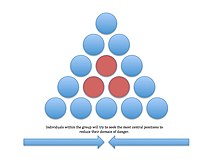
Predation is a biological interaction where one organism, the predator, kills and eats another organism, its prey. It is one of a family of common feeding behaviours that includes parasitism and micropredation and parasitoidism. It is distinct from scavenging on dead prey, though many predators also scavenge; it overlaps with herbivory, as seed predators and destructive frugivores are predators.
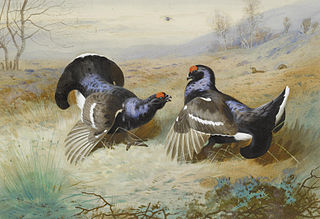
Group selection is a proposed mechanism of evolution in which natural selection acts at the level of the group, instead of at the level of the individual or gene.

Foraging is searching for wild food resources. It affects an animal's fitness because it plays an important role in an animal's ability to survive and reproduce. Foraging theory is a branch of behavioral ecology that studies the foraging behavior of animals in response to the environment where the animal lives.

The Eurasian minnow, minnow, or common minnow is a small species of freshwater fish in the carp family Cyprinidae. It is the type species of genus Phoxinus. It is ubiquitous throughout much of Eurasia, from Britain and Spain to eastern Siberia, predominantly in cool streams and well-oxygenated lakes and ponds. It is noted for being a gregarious species, shoaling in large numbers.

Safety in numbers is the hypothesis that, by being part of a large physical group or mass, an individual is less likely to be the victim of a mishap, accident, attack, or other bad event. Some related theories also argue that mass behaviour can reduce accident risks, such as in traffic safety – in this case, the safety effect creates an actual reduction of danger, rather than just a redistribution over a larger group.

A herd is a social group of certain animals of the same species, either wild or domestic. The form of collective animal behavior associated with this is called herding. These animals are known as gregarious animals.

Anti-predator adaptations are mechanisms developed through evolution that assist prey organisms in their constant struggle against predators. Throughout the animal kingdom, adaptations have evolved for every stage of this struggle, namely by avoiding detection, warding off attack, fighting back, or escaping when caught.

In 1938, the Austrian ethologist Karl von Frisch made his first report on the existence of the chemical alarm signal known as Schreckstoff in minnows. An alarm signal is a response produced by an individual, the "sender", reacting to a hazard that warns other animals, the receivers, of danger. This chemical alarm signal is released only when the sender incurs mechanical damage, such as when it has been caught by a predator, and is detected by the olfactory system. When this signal reaches the receivers, they perceive a greater predation risk and exhibit an antipredator response. Since populations of fish exhibiting this trait survive more successfully, the trait is maintained via natural selection. While the evolution of this signal was once a topic of great debate, recent evidence suggests schreckstoff evolved as a defense against environmental stressors such as pathogens, parasites, and UVB radiation and that it was later co-opted by predators and prey as a chemical signal.
The Allee effect is a phenomenon in biology characterized by a correlation between population size or density and the mean individual fitness of a population or species.

A Darwinian puzzle is a trait that appears to reduce the fitness of individuals that possess it. Such traits attract the attention of evolutionary biologists. Several human traits pose challenges to evolutionary thinking, as they are relatively prevalent but are associated with lower reproductive success through reduced fertility and/or longevity. Some of the classic examples include: left handedness, menopause, and mental disorders. These traits are also found in animals, a peacock shows an example of a trait that may reduce its fitness. The bigger the tail, the easier it is seen by predators and it also may hinder the movement of the peacock. Darwin, in fact, solved this "puzzle" by explaining the peacock's tail as evidence of sexual selection; a bigger tail confers evolutionary fitness on the male by allowing it to attract more females than other males with shorter tails. The phrase "Darwinian puzzle" itself is rare and of unclear origin; it's typically talked about in the context of animal behavior.
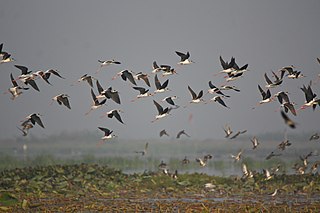
A flock is a gathering of individual birds to forage or travel collectively. Avian flocks are typically associated with migration. Flocking also offers foraging benefits and protection from predators, although flocking can have costs for individual members.

Mobbing in animals is an antipredator adaptation in which individuals of prey species mob a predator by cooperatively attacking or harassing it, usually to protect their offspring. A simple definition of mobbing is an assemblage of individuals around a potentially dangerous predator. This is most frequently seen in birds, though it is also known to occur in many other animals such as the meerkat and some bovines. While mobbing has evolved independently in many species, it only tends to be present in those whose young are frequently preyed upon. This behavior may complement cryptic adaptations in the offspring themselves, such as camouflage and hiding. Mobbing calls may be used to summon nearby individuals to cooperate in the attack.
Spatial organization can be observed when components of an abiotic or biological group are arranged non-randomly in space. Abiotic patterns, such as the ripple formations in sand dunes or the oscillating wave patterns of the Belousov–Zhabotinsky reaction emerge after thousands of particles interact millions of times. On the other hand, individuals in biological groups may be arranged non-randomly due to selfish behavior, dominance interactions, or cooperative behavior. W. D. Hamilton (1971) proposed that in a non-related "herd" of animals, the spatial organization is likely a result of the selfish interests of individuals trying to acquire food or avoid predation. On the other hand, spatial arrangements have also been observed among highly related members of eusocial groups, suggesting that the arrangement of individuals may provide advantages for the group.
Herd behavior is the behavior of individuals in a group acting collectively without centralized direction. Herd behavior occurs in animals in herds, packs, bird flocks, fish schools and so on, as well as in humans. Voting, demonstrations, riots, general strikes, sporting events, religious gatherings, everyday decision-making, judgement and opinion-forming, are all forms of human-based herd behavior.
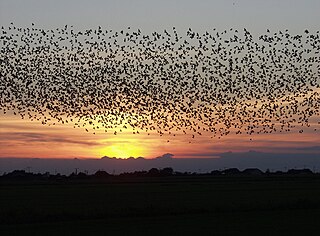
Collective animal behaviour is a form of social behavior involving the coordinated behavior of large groups of similar animals as well as emergent properties of these groups. This can include the costs and benefits of group membership, the transfer of information, decision-making process, locomotion and synchronization of the group. Studying the principles of collective animal behavior has relevance to human engineering problems through the philosophy of biomimetics. For instance, determining the rules by which an individual animal navigates relative to its neighbors in a group can lead to advances in the deployment and control of groups of swimming or flying micro-robots such as UAVs.
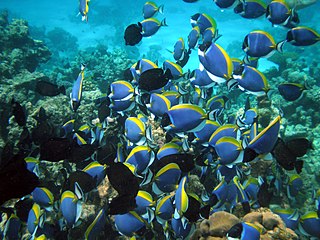
In biology, any group of fish that stay together for social reasons are shoaling, and if the group is swimming in the same direction in a coordinated manner, they are schooling. In common usage, the terms are sometimes used rather loosely. About one quarter of fish species shoal all their lives, and about one half shoal for part of their lives.
Antipredatory behaviors are actions an animal performs to reduce or rid themselves of the risk of being prey. Many studies have been done on elk to see what their antipredator behaviors consist of.
Vigilance, in the field of behavioural ecology, refers to an animal's monitoring of its surroundings in order to heighten awareness of predator presence. Vigilance is an important behaviour during foraging as animals must often venture away from the safety of shelter to find food. However, being vigilant comes at the expense of time spent feeding, so there is a trade-off between the two. The length of time animals devote to vigilance is dependent on many factors including predation risk and hunger.

Pursuit predation is a form of predation in which predators actively give chase to their prey, either solitarily or as a group. It is an alternate predation strategy to ambush predation — pursuit predators rely on superior speed, endurance and/or teamwork to seize the prey, while ambush predators use concealment, luring, exploiting of surroundings and the element of surprise to capture the prey. While the two patterns of predation are not mutually exclusive, morphological differences in an organism's body plan can create an evolutionary bias favoring either type of predation.
In ethology and evolutionary biology, group living is defined as individuals of the same species (conspecifics), maintaining spatial proximity with one another over time with mechanisms of social attraction. Solitary life in animals is considered to be the ancestral state of living; and group living has thus evolved independently in many species of animals. Therefore, species that form groups through social interaction will result in a group of individuals that gain an evolutionary advantage, such as increased protection against predators, access to potential mates, increased foraging efficiency and the access to social information.
